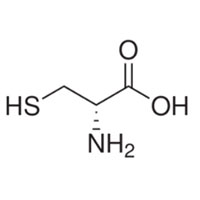



| N/A |
| Packing | |
|---|---|
| Storage | Powder -20°C 3 years 4°C 2 years;In solvent -80°C 6 months, -20°C 1 month |
| Shipping | Room temperature in continental US; may vary elsewhere |
Tel: 0086-25-52397805
Email: info@alchemist-chem.com

| Common Names | D-Cysteine | ||
|---|---|---|---|
| Structure |  |
||
| CAS No. | 921-01-7 | Boiling Point (℃) | 293.9±35.0 °C at 760 mmHg |
| Molecular Weight | 121.158 | Melting Point (℃) | 230ºC |
| Density | 1.3±0.1 g/cm3 | Vapor Specific Gravity | N/A |
| Molecular Formula | C3H7NO2S | Flash Point (℃) | 131.5±25.9 °C |
| Solubility | N/A | Autoignition Temperature (℃) | N/A |
| Personal Protective Equipment | Eyeshields;Gloves;type N95 (US);type P1 (EN143) respirator filter | ||
|---|---|---|---|
| Hazard Codes | T+:Very toxic | ||
| Safety Phrases | S1-S28-S45 | ||
| RIDADR | NONH for all modes of transport | ||
| WGK Germany | 3 | ||
| SYMPTOMS | PREVENTION | FIRST AID | |
| Inhalation | Cough. Sore throat. | Use local exhaust or breathing protection. | Fresh air, rest. |
| Skin | Redness. Burning sensation. Itching. | Protective gloves. | Remove contaminated clothes. Rinse and then wash skin with water and soap. |
| Eyes | Redness. Pain. | Wear safety goggles. | First rinse with plenty of water for several minutes (remove contact lenses if easily possible), then refer for medical attention. |
| Ingestion | Abdominal pain. Nausea. Vomiting. | Do not eat, drink, or smoke during work. Wash hands before eating. | Rinse mouth. Induce vomiting (ONLY IN CONSCIOUS PERSONS!). Refer for medical attention. |
| Description | D-Cysteine is the D-isomer of cysteine and a powerful inhibitor of Escherichia coli growth. D-cysteine is mediated by D-amino acid oxidase to produce H2S and is a neuroprotectant against cerebellar ataxias. D-Cysteine could inhibit the growth and cariogenic virulence of dual-species biofilms formed by S. mutans and S. sanguinis[1][2][3]. | ||
|---|---|---|---|
| Target | Human Endogenous Metabolite | ||
| In Vitro | DL-Lysine (Lys) is a high affinity, basic amino acid substrate for amino acid transporter b0,+ with Km value ranging from 100-400 μM[1]. | ||
| References | [1]. Seki T. Availability of D-cysteine as a protectant for cerebellar neurons. Nihon
Yakurigaku Zasshi. 2019;154(3):133-137. [2]. Soutourina J, et al. Role of D-cysteine desulfhydrase in the adaptation of Escherichia coli to D-cysteine. J Biol Chem. 2001 Nov 2;276(44):40864-72. [3]. Guo X1, et al. Effect of D-cysteine on dual-species biofilms of Streptococcus mutans and Streptococcus sanguinis. Sci Rep. 2019 Apr 30;9(1):6689. |
||